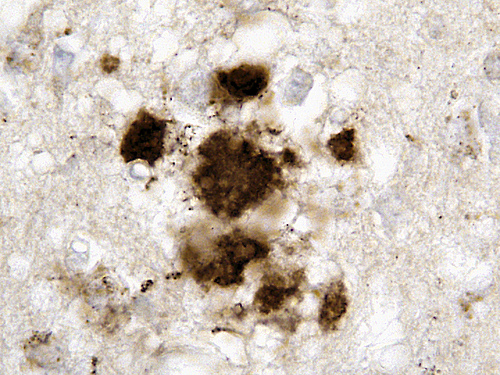 These round, packed deposits of abnormal prion protein are known as florid plaque. They often form in the brains of people suffering from variant Creutzfeld-Jakob disease (vCJD).
These round, packed deposits of abnormal prion protein are known as florid plaque. They often form in the brains of people suffering from variant Creutzfeld-Jakob disease (vCJD).
Cannibalism. One of the last, great taboos. And for good biological reasons. In the Eastern Highlands of Papua New Guinea the locals, known as the Fore, practiced what was politely called "transumption," which led during the late 1950s to the person-to-person transmission of a debilitating disease, kuru, in epidemic proportions. The "laughing disease" led to massive neural degeneration, eventually resulting in death (although sometimes with long latency periods), and was the result of the transmission of prions.
Prions are interesting because they’re sort of the exception that proves the rule of DNA. That is, while DNA replicates sequence, prions replicate conformation. Prions are peptides or proteins that assume a particular conformation. When a prion comes in contact with a similar protein that is not shaped the same the prion forces the protein to assume its conformation, and they aggregate together in a tight knit architecture known as an amyloid. This is the same sort of amyloid that occurs in the very similar prion disease Creutzfeld-Jakob disease (CJD) and in Alzheimer’s. So, you can sort of think of prions as the first domino that initiates a cascade of conformational events that leads to a big, tangled mess in your brain. Not good.
Here’s what’s been making me think. There is a variant of CJD (vCJD) that arose a few years ago in England and that could be traced, roughly, to the widespread distribution of what Denny Crane would call “the mad cow disease,” but which is more commonly known as Bovine Spongiform Encephelapathy. Here’s what I find fascinating: you feed cows the remains or waste of other cows, BSE can spread like wildfire (and who can forget the giant bonfires of cows in England circa the late 1980s). But while there were upwards of 180,000 cases of BSE amongst cows, there were only about 153 cases of vCJD (Beghi et al. (2004), Neurol Sci 25:122). The causal link between BSE and vCJD is sort of like the causal link between human activity and global warming: pretty convincing evidence, but hard to definitively prove (and in both cases the appropriate experiments that might directly test the hypotheses are understandably hard to run).
Some folks think that the low transmission rates from cows to humans just hide an epidemic-to-come in which those of us who consume multiple hamburgers per day (what?) will eventually twitch out. But it is more likely that there are huge species barriers in prion replication. This is because at the molecular level a cow prion may only partially recognize and bind to the amino acid sequence in the corresponding normal human protein, inhibiting the kicking over of that first domino (Priola (1999), Biomed Pharmacother 53:27).
This presumed species barrier is confirmed by experiments with prion transmission in test tubes, cells, and transgenic mice. Thus, cow-on-cow or human-on-human chomping is a much more likely route to disease than humans eating cows (or whatever happens in the future on the Gary Larson-esque “Planet of the Cows”).
So, what are the implications of this understanding? Clearly, don’t eat people, soylent or not. Indeed, the depth of the taboo suggests that our species may have discovered this edict several times over in our past (and there is even a serious-but-unlikely hypothesis that cannibalistic Neanderthals succumbed to spongiform encephalopathies). Keep your factory farms clean. Amusingly, many of the bans on beef that accompanied the outbreak of BSE in England (and more minor outbreaks in the US) were more political than practical.
But I think there’s also a more fundamental issue. While spongiform encephalopathies seem to focus on a relatively small number of neurologically important proteins, a surprisingly huge number of proteins can form amyloids. Indeed, work from the Marcotte lab down the hall (with a small assist from our own lab) has revealed that a surprisingly large number of yeast proteins (like, 30%, of all proteins) seem to self-aggregate. To the extent that those aggregates are amyloids this would mean that there are many dominoes waiting to fall. Why don’t they? Well, most proteins inside of cells are disentangled by energy-burning so-called chaperones (and, indeed, the prion protein that falls down is on the *outside* of cells in the brain).
Indeed, the fact that we’re not cannibals means we don’t know much about these other dominos. Or, to put it another way, prions are a growth industry from a biodefense point of view. How many different human peptides, available orally, just like kuru was, would inevitably take down large fractions of a population after a suitably long and stealthy incubation period? And given the concerns I’ve previously noted about the quality controls in our supply chains (see “On Pepcid,” which incidentally is back on the shelves, woo hoo!), would such prions be relatively easy to introduce (think melamine)? And unlike viral or microbial diseases, where we at least have a basal understanding of how to construct a biodefense, there really is no defense against prions (just as, sadly, there is no real cure for Alzheimer’s). The suggested procedures for prion researchers to decontaminate their workspaces and tools involve essentially treating everything with the most caustic agents you can imagine. That’s not going to work for your brain. And so I am left once again with a conclusion that is an unsatisfying bummer: we’re hosed. Unless the same cultural prohibitions that keep us from eating one another kick in with respect to infecting one another. The thin, nice line. Quaint.


















Comments